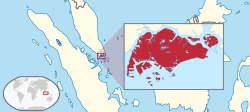Kingdom of Singapura
| Kingdom of Singapura | ||||||||||
| Kerajaan Singapura | ||||||||||
|
||||||||||
|
Location of Kingdom of Singapura (red)
|
||||||||||
| Capital | Singapura | |||||||||
| Languages | Old Malay | |||||||||
| Religion | Syncretic form of Hinduism, Buddhism and Animism; Islam | |||||||||
| Government | Monarchy | |||||||||
| King | ||||||||||
| • | 1299–1347 | Sang Nila Utama (Sri Tri Buana) | ||||||||
| • | 1347–1362 | Sri Wikrama Wira | ||||||||
| • | 1362–1375 | Sri Rana Wikrama | ||||||||
| • | 1375–1389 | Sri Maharaja | ||||||||
| • | 1389–1398 | Parameswara (Sri Iskandar Shah) | ||||||||
| History | ||||||||||
| • | Founding of Temasek by Sang Nila Utama | 1299 | ||||||||
| • | Siege by Siam | c. 1330 | ||||||||
| • | Siege by Majapahit under Hayam Wuruk | 1350 | ||||||||
| • | Majapahit Invasion and escape of Parameswara (Sri Iskandar Shah) to the Malay Peninsula | 1398 | ||||||||
| Currency | Native gold and silver coins | |||||||||
|
||||||||||
| Today part of |
|
|||||||||
The Kingdom of Singapura (Malay: Kerajaan Singapura) was a Malay kingdom thought to exist on the island of Singapore from 1299 until its fall in 1398. Conventional historical view marks circa 1299 as the founding year of the kingdom by Sang Nila Utama (also known as "Sri Tri Buana"), whose father is Sang Sapurba, who according to legend is the common great ancestor of most of the Malay monarchies in the Malay World. The historicity of this kingdom, based on the account given in the Malay Annals, is the subject of academic debates, and many historians consider only its last ruler Parameswara (or Sri Iskandar Shah) a true historical figure. Archaeological evidence from Fort Canning and the nearby banks of the Singapore River has nevertheless demonstrated the existence of a thriving settlement and a trade port in the 14th century.
The settlement developed in the 13th or 14th century and rose from a small Srivijayan trading outpost into a centre of international trade with ties to the Yuan Dynasty. It was however claimed by two regional powers at that time, Ayuthaya from the north and Majapahit from the south. As a result, the kingdom's fortified capital was attacked by at least two major foreign invasions before it was finally sacked by the Majapahit in 1398 according to the Malay Annals, or the Siamese according to Portuguese sources. The last king, Parameswara or Iskandar Shah, fled to the west coast of the Malay Peninsula to establish the Malacca Sultanate in 1400.
The name Singapura is derived from Sanskrit meaning "Lion City".Singa comes from the Sanskrit word siṃha, which means "lion", and pūra means "city" in Sanskrit. According to the Malay Annals, Sri Tri Buana and his men were exploring Tanjong Bemban while in Bintan when he spotted an island with white sandy beach from a high point. On learning that the island was called Temasek, they set sail for the island, but encountered a severe storm on the way. After they managed to land safely on the island, they went to hunt for wild animals. He suddenly saw a strange animal with an red body, black head and a white neck breast. It was a fine-looking animal and moved with great speed as it disappeared into the jungle. He asked his chief minister, Demang Lebar Daun, what animal it was, and was told that it probably was a lion. He then decided to stay in Temasek, named the city he founded Singapura or "Lion City".
...
Wikipedia

